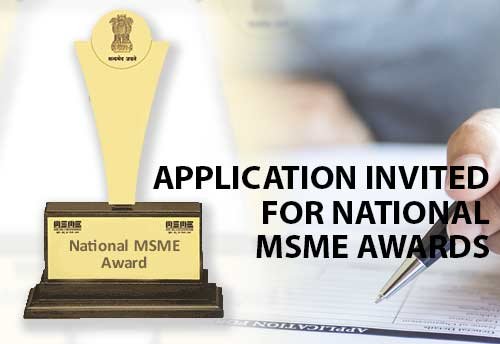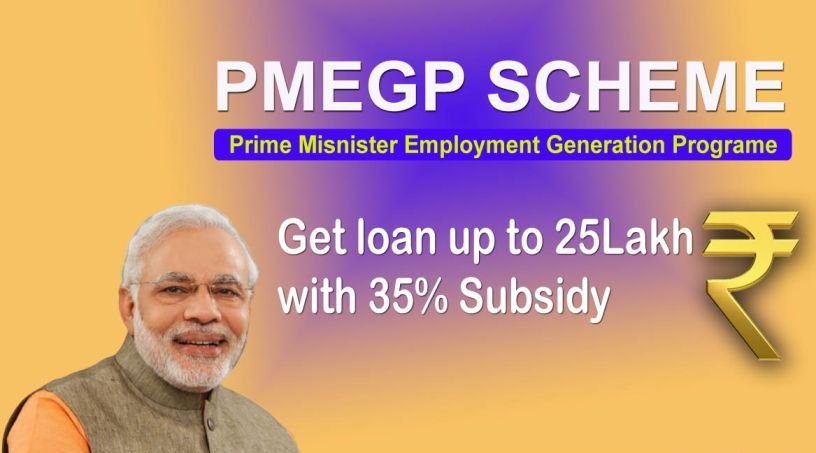
Scheme of National Awards for MSMEs
O/o DC(MSME) New Delhi is inviting applications from eligible MSME Units for National Awards. The modified scheme guidelines are available at https://dashboard.msme.gov.in/na/Ent_NA_Admin/NA_Guidelines.pdf
The applicants have to submit online applications at https://dashboard.msme.gov.in/na. It is requested to kindly disseminate this information amongst eligible award worthy MSME units under your jurisdiction.

Exploring the Impact of Government of India’s Women Empowerment Initiatives
The Government of India has implemented several initiatives to empower women and promote gender equality. Some of the key initiatives include:
- Beti Bachao Beti Padhao (BBBP): Launched in 2015, this program aims to improve the welfare of girls and reduce gender discrimination by promoting education and awareness. It focuses on improving the sex ratio and preventing female infanticide, as well as providing education and vocational training to girls.
- Pradhan Mantri Matru Vandana Yojana (PMMVY): Implemented in 2017, this scheme provides financial assistance to pregnant and lactating women for their medical expenses and nutrition.
- Mahila E-Haat: Launched in 2016, this online marketplace allows women entrepreneurs and artisans to showcase and sell their products.
- Sukanya Samriddhi Yojana: This scheme, launched in 2015, aims to provide financial security for the girl child’s education and marriage.
- National Mission for Empowerment of Women: Implemented in 2010, this mission aims to empower women through various programs such as education, health, and livelihoods.
- Working Women’s Hostel: This scheme provides affordable accommodation for working women, particularly those in rural areas.
- One Stop Centre: Implemented in 2015, these centers provide support and assistance to women facing violence and abuse.
- Mahila Police Volunteer: This initiative, launched in 2018, aims to empower women and increase their participation in community policing.
- Ujjawala: Launched in 2016, this scheme aims to rescue and rehabilitate women and children who are victims of trafficking.
- National Policy for the Empowerment of Women: This policy, adopted in 2001, aims to empower women through education, employment, and political participation.
These are some of the major initiatives undertaken by the Government of India to empower women and promote gender equality. While progress has been made, there is still a long way to go to ensure that women have equal access to opportunities and resources.

Upcoming Trade Fairs
Ministry of MSME invites applications for participation in various Trade Fairs under their Procurement and Marketing Scheme (PMS Scheme) 5A Component.
Please click here to view upcoming Exhibitions / Trade Fairs. The columns marked in Green are Fairs where enrollments are in progress.
Please click here to read/download the PMS Scheme Guidelines

Govt extends PMEGP scheme for five more years with Rs 13.5k crore outlay
Ease of Doing Business for MSMEs: The government on Monday announced the extension of its scheme for employment generation Prime Minister’s Employment Generation Programme (PMEGP) over the 15th Finance Commission Cycle from 2021-22 to 2025-26 with an outlay of Rs 13,554.42 crore. In addition, multiple modifications have also been made to the scheme including increasing the maximum financial assistance offered from existing Rs 25 lakh to Rs 50 lakh to entrepreneurs for setting up new manufacturing units and from existing Rs 10 lakh to Rs 20 lakh for new service units.
Launched in 2008-09, the scheme has supported around 7.8 lakh micro enterprises with a subsidy of Rs 19,995 crore to create employment for around 64 lakh people, the MSME Ministry said in a statement. Around 80 per cent of the units assisted under PMEGP are in rural areas and about 50 per cent units are owned by scheduled caste, scheduled tribe and women entrepreneurs. Khadi and Village Industries Commission (KVIC) is the national nodal agency of the scheme.
The scheme also modified its definition of village industry and rural area to include areas falling Panchayati Raj institutions to be accounted under rural areas and areas under municipality to be recognised as urban areas. Moreover, all implementing agencies including state and district level state offices of KVIC, state KVIBs and district industries centres have been allowed to receive and process applications in all areas irrespective of the rural or urban category.
The government said the extension will create sustainable estimated employment opportunities for about 40 lakh people in five financial years. The margin money subsidy to be given to potential entrepreneurs would be 25 per cent of the project cost in urban areas and 35 per cent in rural areas for special category applicants including SC, ST, OBC, women, transgender, physically disabled, north-eastern region, aspirational and border district applicants, according to the guidelines. For General category applicants, 15 per cent subsidy of the project cost would be provided in urban areas and 25 per cent in rural areas.
Meanwhile, the number of jobs generated under the scheme through new enterprises set up had hit a record high of 8,25,752 in FY22, the Ministry had said in April this year. Also, the number of enterprises set up during the year jumped over 1 lakh to 1,03,219 for the first time in the past 14 years. The growth in units set-up and employment created under PMEGP in FY22 was up by 39 per cent each from FY21, while the margin money distribution (subsidy) had jumped 36 per cent.
Business Loan
Business loan is a credit facility offered by Banks and NBFCs to meet the financial requirements of self-employed customers and enterprises. It can be availed by individuals, MSMEs, business owners, entrepreneurs, professionals (CAs/Doctors), and several other business entities.
Business loans are majorly classified into two types, such as secured loans and unsecured loans. Secured loans are types of loans that require collateral/security, that a borrower needs to deposit with the lender to avail a business loan. However, in the case of unsecured loans, there is no need to submit any collateral/security with the bank, NBFC, or any other lender.
Banks/NBFCs offer both secured and unsecured business loans, including Term Loan (Short-term/Long-term), Working Capital Loans, Cash Credit, Overdraft, Letter of Credit, Bill/Invoice Discounting, Equipment Finance, Machinery Loans, POS loans, Loan under Bank Guarantee, Loan under Govt. schemes, etc.
The minimum loan amount offered starts from as low as Rs. 30,000 that can be availed from Small Finance Banks (SFBs), Regional Rural Banks (RRBs), or Micro Finance Institutions (MFIs). Borrowers can avail collateral-free business loans for up to Rs. 1 crore from leading private and public sector banks. Small business loans are also available for MSMEs and Startups at competitive interest rates.
On our online platform, the business loan interest rates offered by financial institutions start from 16% p.a. onwards and are further determined as per the applicant’s profile, eligibility & business requirements. Below mentioned are the business loan interest rates offered by leading banks and NBFCs.
| Bank/NBFC/Fintech | Interest Rate |
| IIFL Finance | 11.75% – 25.75% p.a. |
| HDFC Bank | 11.90% – 21.35% p.a. |
| FlexiLoans | 1% per month onwards |
| ZipLoan | 1% – 1.5% per month (Flat ROI) |
| Axis Bank | 14.25% – 18.50% p.a. |
| IDFC First Bank | 14.50% p.a. onwards |
| Kotak Mahindra Bank | 16% – 19.99% p.a. |
| Fullerton Finance | 17% – 21% p.a. |
| Bajaj Finserv | 17% p.a. onwards |
| RBL Bank | 17.50% – 25% p.a. |
| ICICI Bank | 18% p.a. onwards |
| Indifi Finance | 1.5% per month onwards |
| Lendingkart Finance | 1.5% – 2% per month |
| Tata Capital Finance | 19% p.a. onwards |
| NeoGrowth Finance | 19% – 24% p.a. |
| Hero FinCorp | Up to 26% p.a. |
Interest Rates are updated as on April 2022.
Credit Scores
Credit score plays a significant role in the loan approval process. It represents your credit history along with the repayment timeline of availed funding products. Generally, any credit score of 750 or more is considered good by the financial institutions. However, if your credit score is bit low of 650 or above, there are still chances of loan approval from some NBFCs, Small Finance Banks and Micro Finance Institutions.
The credit score eligibility defined by financial institutions are different for individuals, self-employed professionals, MSMEs, retailers or manufacturers and other business entities.
Different ranges of credit score is required by banks/NBFCs, from borrowers who require various types of business loans, such as term loan, working capital loan, letter of credit, overdraft, POS loans, etc. The credit score range defined by the lender for a specific loan product shall vary from applicant to applicant and loan types.
People with New-to-Credit should also start to build a credit score for loan approvals, as applicants with low credit scores are always at higher risk of loan rejections. Startups require even higher credit scores to avail business loans and they are new to the lending market and are about to set up a new business. Therefore, build and maintain a good credit score to enhance the chance of loan approval.
Eligibility Criteria
- Business Tenure: Minimum 1 year or above
- Minimum Annual Turnover: Rs. 12 lakh or above for existing enterprises
- Credit Score: 750 or above
- Applicants with No past loan defaults
Eligible Entities
- Individuals, Business Owners, Entrepreneurs, Self-employed professionals, Startups and Micro, Small, and Medium Enterprises (MSMEs)
- Private and Public Limited Companies, Sole Proprietorship, Partnership Firms, Limited Liability Partnerships, and Large Enterprises engaged only in Manufacturing, Trading or Services sectors
- NGOs, Co-operative Societies, Trusts and professionals, such as CAs, Doctors, Architects, Company Secretaries, Designers, etc.
Documents Required
When applying for a business loan, you will need to submit the following documents:
- Duly filled application form along with passport-sized photographs
- KYC Documents of the applicant, including PAN card, Passport, Aadhar Card, Driving License, Voter ID card, Utility Bills (Water/Electricity Bills)
- Last 1 years’ bank statement
- Copy of Non-Collateral Overdraft, if any
- Copy of Business Incorporation
- Any other document required by the lender

How to write a Business Plan
Business plan is a formal written document that contains your prospective business goal. Business loan includes the process on how to execute these plans, the time period in which the goals have to be attained or executed. The plan consist a list of details which helps a business to achieve certain goals that helps them grow. Plans for attaining business loans also contain the following details:
- Nature of the business
- Background and financial flexibility of the enterprise or business
- All the strategies, business or company wants to undertake to achieve their target
- It works as a road map which provides a direction to the business
- Banks often require a documented business plan to sanction business plan or other kind of financial requirements
Components of a Business Plan
The process of making a good business plan requires the company or firm to stick to a particular structure or template used to make or draft business plans. Well written business plan includes the following:
- Cover page with complete index
- Pitch summary
- The motto or vision statement
- Brief description of the business
- Analysis of the business environment
- SWOT analysis
- Industry background
- Analysis of the competitors
- Market analysis
- Marketing plans
- Operational plans
- Management summary
- Financial planning
- Recent company’s success stories
How to write a Business Plan to Start Your own Business?
How to start a business plan has always been a confusing topic for many firms and organisations. Creating a perfect business plan can prove beneficial for the growth of the firm or business. Creating a business plan involves a lot of research and detailed process which include a lot of stages some of which overlap each other or are inter related. It doesn’t matter if you are drafting a business plan from scratch or a predefined template or working with a business plan writer or consultant, you will find these steps along the way:
- Research: Detailed research includes digging out information about customers, competitors, and a detailed report about working capital cost of the business. A variety of methods can be used to find the following data; the data can be extracted from a variety of methods ranging from articles and data bases to even arranging interviews with other entrepreneurs or even potential customers. Research has to be organised and documented carefully with all the information gathered. The source of the information is to be documented along with the information, as the source has to be mentioned within the business plan
- Strategizing: The information that has been collected has to be used relevantly to support your business plan. Revise the business strategy you planned according to the information gathered. Your research has to be in-depth and precise so that your strategy can provide support to your decision on appropriate marketing, operations of the business or the firm. The rate at which the company shall hire for five years has to be mentioned. Strategy usually pulls the best out the practises present in the current marketing scenario. The companies use this as a base to build a plan in which different activities are added that gives the business a competitive advantage
- Calculation: All the activities and improvement comes at a cost and will generate some revenue from the strategy. The strategy has to be made with the cost of execution and the profits in the long. The strategy has to be on the basis that the profit would cover up the expenses. Start inserting your start-up cost and financial assumptions into a financial model which will provide you with an overview on the flow of cash in the first financial year, this will give an estimate on the funds the business will need on hand to fund the early operations
- Draft: With the strategy more or less decided and an estimate of the provided it is time to draft a business plan. With all the research and the calculations done properly the drafting work is the easiest in the creation of a business plan. If there is a problem in putting forward a convincing prose then this might be the right time to consult or seek the help of a business plan writer who can put together the business plan
- Revision and proofreading: Revising the entire business plan will ensure that you haven’t missed any idea or strategy that was to be added while drafting the business plan. Check whether the words in the business plans do not lead to any confusion. Repetitive, irrelevant or redundant points should be removed or substituted with better ideas that suits the points in the business plan. Finally go through the business plan to find grammatical errors, spelling mistakes and formatting
Types of Business Plans
There are two types of business plans as mentioned below:
A) Internally focused business plan
B) Externally focused business plan
Let’s discuss about these two types in detail.
1. Internally Focused Business Plan
It is a business plan which focuses on the internally focused business targets, intermediate goals which help an organisation to reach their externally focused business plans. An internally focused business plan may contain details like a new service that has been added in the business, a line of new products that the company is going to launch, the restructures in the financial matters of the company, setting up of a new IT system or even the restructuring or renovation of the business or the company. It usually contains a list of recent success the company has achieved.
2. Externally Focused Business Plan
Externally focused business plans which contain detailed information about the organisation or the company or the efforts made by a team to reach their goals. It also contains various list of profit entities, it includes a list of external stakeholders which include investors and customers of the company.
There are different types of externally focused business plans which have different stakeholders, investors and customers. The various types of externally focused business plan are as follows:
- Non-profit based: the external stakeholders are clients and donors
- Profit based: external stakeholders are investors and customers
- Government agencies: external stakeholders are the higher level government bodies, taxpayers, or the international lending bodies. The international lending bodies include international monetary funds, the World Bank and development banks.
FAQs
Ques. What are the questions that are answered by a perfect business plan?
Ans. The questions are as follows;
- What makes you different?
- How is your business going to make money?
- What are the ways to promote your business?
- What is the amount of funds required to get started?
- What is the expected time period to cover your investments?
Ques. How long should be a business plan?
Ans. A business plan can be anywhere near 10 to 100 pages; it always depends on the purpose of the business plan.
Ques. Is it mandatory to write a business plan?
Ans. In case you are interested in taking business loan from a financial institution, then it becomes essential to write a business plan as it is required by lenders before sanctioning any loan.
Ques. Who should write my business plan?
Ans. It is your business so the plan also needs to be written by you ‘the entrepreneur’.
Ques. What are the common mistakes in writing a business plan?
Ans. There are some of the common mistakes in writing a business plan that include ignoring the competition in the entering market, copying an exact plan of someone else, being over optimistic, relying on limited customers, applying too many ideas, etc.

Udyam Registration replaces Udyog Aadhaar
A micro, small and medium enterprise (MSME) will now be known as Udyam as per the notification issued by the Ministry of MSME on 26 June 2020. The ministry has also come up with detailed criteria for the classification of MSMEs and the procedure for registration and the arrangements made by the ministry for facilitation in this process. The notification clarified that exports of goods or services or both shall be excluded while calculating the turnover of any enterprise whether micro, small or medium. It further stated that the registration process will be known as Udyam Registration. The MSME Ministry notified that Udyam Registration can be filed online based on self-declaration with no requirement to upload documents, papers, certificates or proof. An enterprise can be registered just on the basis of Aadhaar number.
The new online registration will be made available from 1 July 2020 at http://www.udyamregistration.gov.in.
Classification of enterprises
An enterprise shall be classified as a micro, small or medium enterprise on the basis of the following criteria, namely –
a micro-enterprise, where the investment in plant and machinery or equipment does not exceed one crore rupees and turnover does not exceed five crore rupees;
a small enterprise, where the investment in plant and machinery or equipment does not exceed ten crore rupees and turnover does not exceed fifty crore rupees; and
a medium enterprise, where the investment in plant and machinery or equipment does not exceed fifty crore rupees and turnover does not exceed two hundred and fifty crore rupees.
Becoming a micro, small or medium enterprise –
Any person who intends to establish a micro, small or medium enterprise may file Udyam Registration online in the Udyam Registration portal, based on self-declaration with no requirement to upload documents, papers, certificates or proof.
On registration, an enterprise (referred to as – Udyam in the Udyam Registration portal) will be assigned a permanent identification number to be known as – Udyam Registration Number.
An e-certificate, namely, – Udyam Registration Certificate shall be issued on completion of the registration process.
Composite criteria of investment and turnover for classification –
A composite criterion of investment and turnover shall apply for classification of an enterprise as micro, small, or medium.
If an enterprise crosses the ceiling limits specified for its present category in either of the two criteria of investment or turnover, it will cease to exist in that category and be placed in the next higher category but no enterprise shall be placed in the lower category unless it goes below the ceiling limits specified for its present category in both the criteria of investment as well as turnover.
All units with Goods and Services Tax Identification Number (GSTIN) listed against the same Permanent Account Number (PAN) shall be collectively treated as one enterprise and the turnover and investment figures for all of such entities shall be seen together and only the aggregate values will be considered for deciding the category as micro, small or medium enterprise
Calculation of investment in plant and machinery or equipment –
The calculation of investment in plant and machinery or equipment will be linked to the Income Tax Return (ITR) of the previous years filed under the Income Tax Act, 1961.
In case of a new enterprise, where no prior ITR is available, the investment will be based on self-declaration of the promoter of the enterprise and such relaxation shall end after the 31st March of the financial year in which it files its first ITR.
The expression ―plant and machinery or equipment‖ of the enterprise, shall have the same meaning as assigned to the plant and machinery in the Income Tax Rules, 1962 framed under the Income Tax Act, 1961 and shall include all tangible assets (other than land and building, furniture and fittings).
The purchase (invoice) value of a plant and machinery or equipment, whether purchased first hand or second hand, shall be taken into account excluding Goods and Services Tax (GST), on self-disclosure basis, if the enterprise is a new one without any ITR.
The cost of certain items specified in the Explanation I to sub-section (1) of section 7 of the Act shall be excluded from the calculation of the amount of investment in plant and machinery.
Calculation of turnover
Exports of goods or services or both shall be excluded while calculating the turnover of any enterprise whether micro, small or medium, for the purposes of classification.
Information as regards turnover and export turnover for an enterprise shall be linked to the Income Tax Act or the Central Goods and Services Act (CGST Act) and the GSTIN.
The turnover related figures of such enterprise which do not have PAN will be considered on self-declaration basis for a period up to 31st March 2021 and thereafter, PAN and GSTIN shall be mandatory.

Revised Classification of MSMEs

Govt extends ECLGS scheme for MSMEs
The Emergency Credit Line Guarantee Scheme (ECLGS) that helped micro, small and medium enterprises get access to additional credit during the outbreak of the COVID-19 pandemic has been extended till March 2023 and its guarantee cover expanded by Rs 50,000 crore to Rs 5 lakh crore, the government said in a press release today. Finance Minister Nirmala Sitharaman while presenting the Union Budget for 2022-23 had announced the extension of the ECLGS till March 2023 and had also said that the additional amount will be exclusively earmarked for the hospitality and related segments to help them recover from the aftermath of the COVID-19 pandemic. As part of the new operational guidelines for ECLGS 3.0, new borrowers from the hospitality, travel, tourism, and civil aviation sectors who have borrowed after March 31, 2021, and up to January 31, 2022, will also now be eligible to avail of emergency credit facilities under ECLGS 3.0. The National Credit Guarantee Trustee Co has also increased the limit for borrowing under the third iteration of the ECLGS. The government has set January 31, 2022, as the reference date for companies to avail of credit as part of the extended ECLGS scheme.
